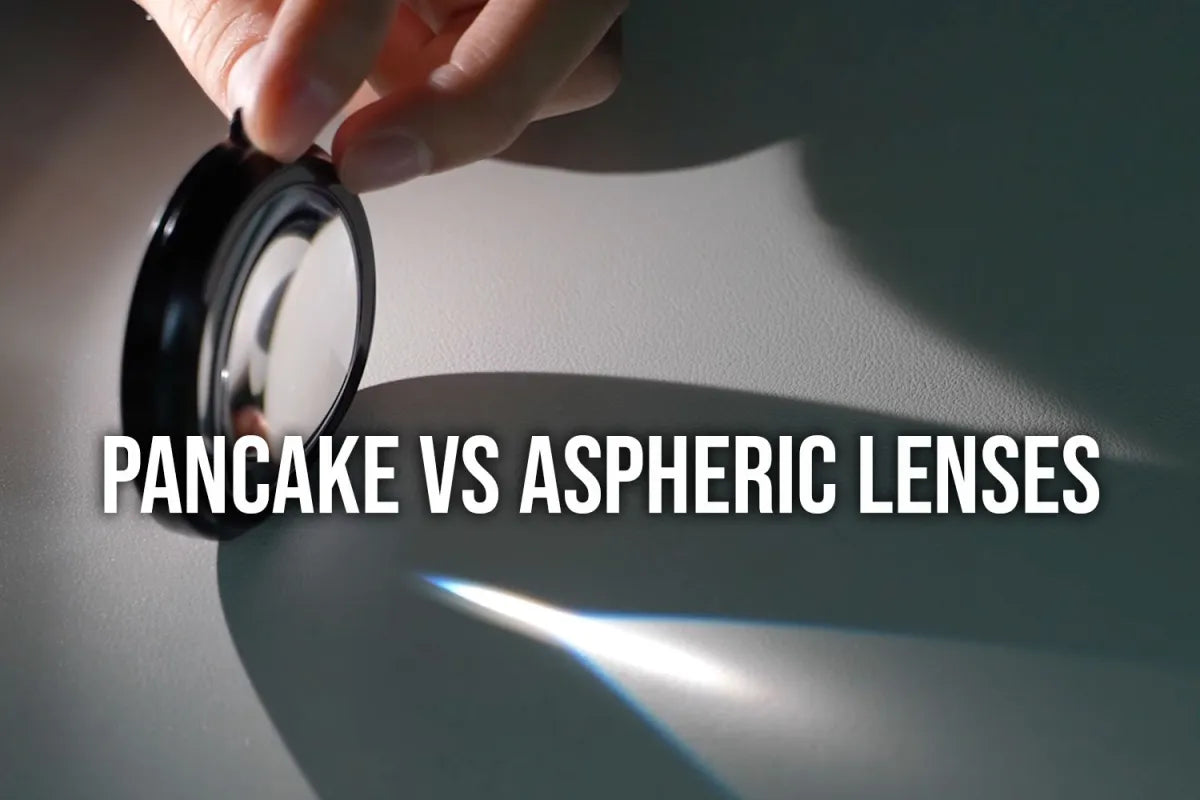All lens designs introduce advantages and compromises. Let’s look at the differences between pancake and aspheric lenses for VR specifically, and why Pimax chooses glass aspheric lenses for the Pimax Crystal.
Pancake Lenses (in VR context)
In VR headset, pancake lenses are a lens module that uses a folded optical path to make the total length of the optical path shorter. Pancake lens is actually a collection of lens elements and film layers tightly packed together, using the interaction between the film layers to make the previously only straight light path reflected between the film layers again and again. However, this kind of folded optical path has an obvious defect, that is, the efficiency for light utilization will drop sharply, and it is difficult if not impossible to create an image clean of ghosting and glare. Because not all the light will pass through the layers, it’ll inevitably cause losses.
If we take an LCD screen, the theoretical utilization rate of light energy is only 25% (the current level of technology that can be achieved is only 20%).
If we take an OLED screen and couple it with pancake lenses, then the theoretical efficiency for light utilization is only 12.5%, the current process can achieve the level of about 10%.
The lost light will become a ghost image after entering the human eye, affecting the clarity of vision and the sense of transparency. In summary, while the size, thickness and weight of pancake lens are satisfactory, the visual limitations are not ideal for high-end devices.
Aspheric lenses (in a VR context)
Aspheric lenses are often used in VR headsets to achieve multiple optical targets. They are designed to correct optical aberrations and distortions, ensuring that users receive a clear, distortion-free view. Aspherical lenses help reduce peripheral distortions, and prevent blurring especially at the edge of the field of view. They are used to optimize the visual quality and clarity of the VR experience.
Aspherical refers to the surface of the lens. This means that the surface of the lens is not perfectly round like a sphere or part of a sphere. Aspherical lenses are constructed in this way to help reduce distortion and control how light leaves the lens and enters the human eye.
In search of clarity
When light passes through the lens, it passes through multiple obstacles. It passes through the air or glass or resin barrier at the entrance and exit of the lens. During this process, some light is blocked and cannot leave the lens. This reduces the brightness of the light and changes its color. This applies to all lenses. Without exception, the light emitted from the lens is always less than the light entering the lens.
The glass aspherical lens on the Pimax Crystal contains only a single glass element in addition to the single glass dust filter in the headset. This means that light can only pass through four air/glass barriers. Since only one lens controls the light, we had to use very high-quality lenses with a well-adjusted distortion curve. The advantage is that most of the light intensity is preserved and we can produce brighter images with less color shift.
Pancake lenses use multiple lenses to get an accurate image and reduce distortion correction, but they also use many components. This means there are more air/polycarbonate barriers. Currently, all pancake lens components in VR headsets use polycarbonate. Plastics that are optically less transparent than glass. This means that there are more light barriers, and because of the choice of these barriers and their lens materials, even more light is blocked.
This means that the Pancake lens can block up to 90% of the light coming from the panel, and more. This means that for the same image, the panel must be nearly twice as bright, and the loss of detail and color accuracy is even greater.
The major benefit of pancake lenses is that the lenses can be much smaller and thinner. However, they do not provide the best possible image quality.
At Pimax we want to create the best image possible with our Crystal so we utilize a single glass lens element, constructed to exacting standards, to ensure that we are giving the user the best possible image through the lens.
Optical glass aspheric lenses offer a light passthrough of about 99% and offer very high PPD capabilities at a cost of thicker materials and a higher weight. Our panels shine brighter through the lens than most, and the extra leeway in panel brightness means that we are HDR-compatible. For high-end headsets that focus on bright, high-resolution images, this design is ideal.









